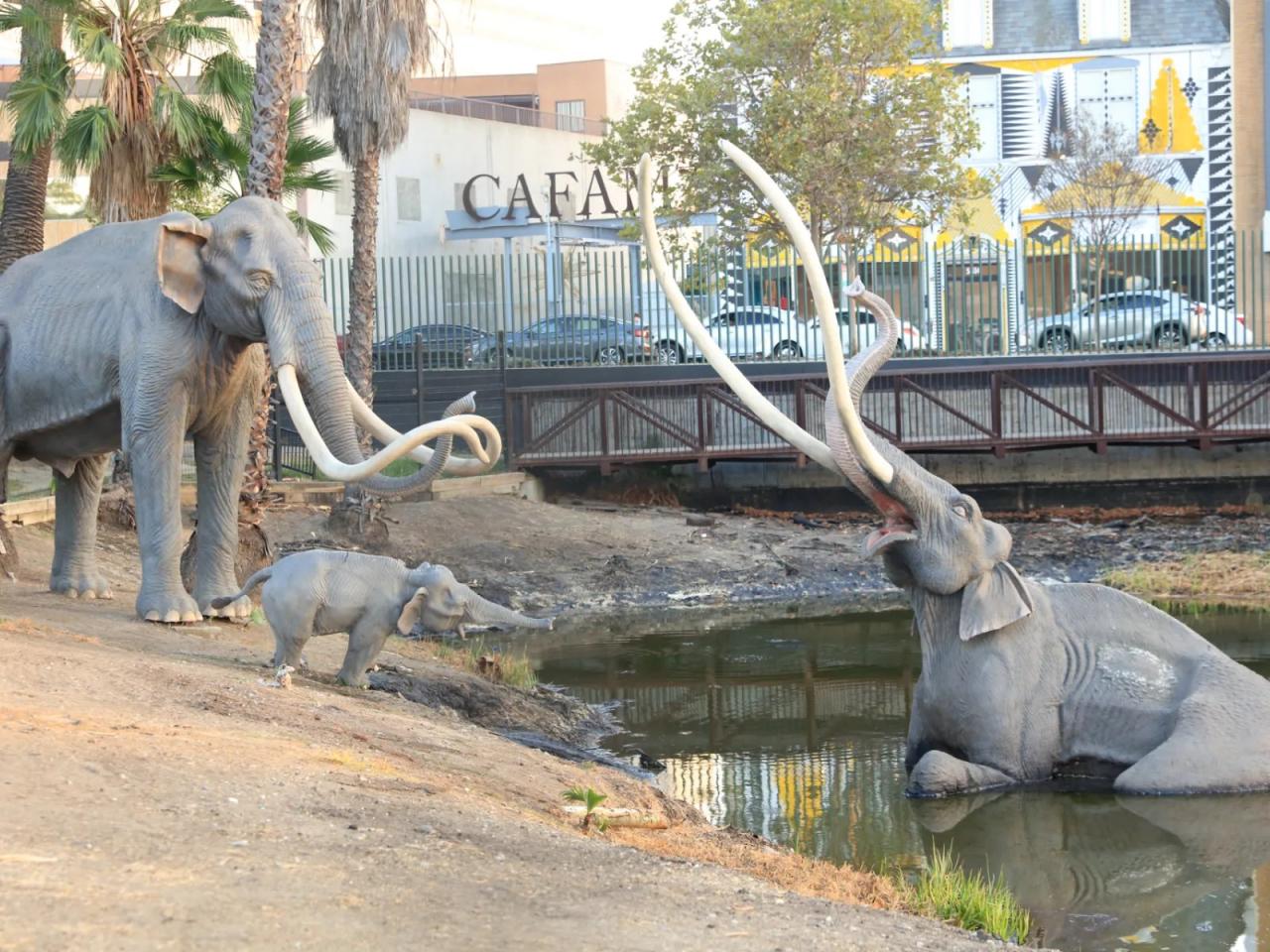California city whose name means tar – La Brea, a city in California, has a unique history tied to the substance that gives it its name: tar. From its humble beginnings to its modern-day significance, La Brea’s journey is a fascinating exploration of industry, culture, and environmental impact.
Established in 1911, La Brea’s origins lie in the tar pits that once dotted the area. These pits, formed over millennia as natural seeps of crude oil surfaced and oxidized, attracted animals and humans alike. The tar’s sticky nature trapped these creatures, preserving their remains for millions of years.
Historical Context

The city of Brea, California, derived its name from the Spanish word “brea,” meaning “tar.” This etymology stems from the abundance of tar pits found within the city’s boundaries, which were once a major source of asphalt for road construction and other industrial purposes.
The Brea Tar Pits, as they are known today, were formed over millions of years as a result of natural seeps of crude oil from underground reservoirs. Over time, the oil oxidized and solidified, creating vast deposits of tar. These tar pits have yielded a wealth of paleontological discoveries, including the remains of extinct animals such as mammoths, saber-toothed cats, and dire wolves.
Timeline of Significant Events
- 1895: Brea Tar Pits are discovered by workers excavating for a water reservoir.
- 1913: The Brea Tar Pits are designated as a National Historic Landmark.
- 1924: The Page Museum of La Brea Discoveries is established to house and display the fossils found at the tar pits.
- 1969: The Brea Tar Pits are declared a National Natural Landmark.
- 1993: The Brea Tar Pits are listed on the National Register of Historic Places.
Geographical Features

The city of La Brea, California, is located in the Los Angeles Basin, approximately 10 miles (16 kilometers) southwest of downtown Los Angeles. The city is situated on a low-lying plain that is surrounded by the Santa Monica Mountains to the north and the Palos Verdes Hills to the south.
The Los Angeles River flows through the city, and the Pacific Ocean is located approximately 5 miles (8 kilometers) to the west.
The presence of tar has had a significant impact on the geography and ecosystem of La Brea. The tar pits, which are located in the center of the city, are a unique natural feature that has attracted scientists and tourists for centuries.
The tar pits are formed by the seepage of crude oil from underground reservoirs, and they have been trapping animals and plants for thousands of years. The tar pits have yielded a wealth of fossils, including the remains of saber-toothed cats, mammoths, and dire wolves.
Impact of Tar on the Ecosystem
The tar pits have had a significant impact on the ecosystem of La Brea. The tar pits have created a unique habitat for a variety of plants and animals, including many that are not found anywhere else in the world.
The tar pits have also been a source of food for humans for thousands of years. However, the tar pits can also be a hazard to wildlife, and many animals have become trapped in the tar and died.
Economic Significance

The presence of tar in California City has played a significant role in the development of its economy. The extraction and processing of tar have created employment opportunities and attracted industries that utilize tar as a raw material.
The tar industry in California City has benefited various sectors, including construction, manufacturing, and energy. The use of tar in road construction, roofing materials, and sealants has supported the growth of the construction industry. The chemical industry has also benefited from tar, which serves as a feedstock for the production of various chemicals, including creosote and pitch.
Tar Extraction and Processing
The extraction and processing of tar in California City involves several stages. The tar is initially extracted from the ground through mining operations. The extracted tar is then processed to remove impurities and prepare it for industrial use. The processing typically includes heating the tar to separate it from other materials and filtering it to remove contaminants.
Tar-Based Industries, California city whose name means tar
- Construction:Tar is widely used in the construction industry for paving roads, roofing materials, and sealants. Its adhesive properties and resistance to water damage make it a suitable material for these applications.
- Manufacturing:Tar serves as a raw material for the production of various chemicals, including creosote and pitch. Creosote is used as a wood preservative, while pitch is used in the manufacturing of roofing materials, paints, and adhesives.
- Energy:Tar can be used as a fuel source in certain industrial applications. It is sometimes used as a substitute for coal or natural gas in boilers and furnaces.
Cultural Impact

Tar, the substance that gave California City its name, has had a significant cultural impact on the city.
The city’s annual Tar Festival celebrates the city’s tar heritage. The festival features a variety of tar-themed activities, including a tar-pouring contest, a tar-sculpting contest, and a tar-eating contest.
Local Traditions
- Tar-pouring contest: Participants compete to see who can pour the most tar in a given amount of time.
- Tar-sculpting contest: Participants compete to create the most creative tar sculpture.
- Tar-eating contest: Participants compete to see who can eat the most tar in a given amount of time.
In addition to the Tar Festival, tar has also influenced the city’s art and architecture.
Art and Architecture
- Tar has been used as a building material in California City. The city’s first schoolhouse was built out of tar.
- Tar has also been used to create sculptures and other works of art. The city’s most famous tar sculpture is a replica of the Statue of Liberty.
Environmental Considerations: California City Whose Name Means Tar

The extraction and processing of tar can have significant environmental impacts. Tar extraction often involves the removal of large amounts of soil and vegetation, which can disrupt local ecosystems and contribute to soil erosion. The processing of tar also releases pollutants into the air and water, which can harm human health and the environment.
To mitigate the negative effects of tar extraction and processing, several measures can be taken. These include:
Minimizing Soil and Vegetation Removal
- Using selective extraction methods to minimize the amount of soil and vegetation removed.
- Revegetating disturbed areas to restore the ecosystem.
Controlling Air and Water Pollution
- Using air pollution control devices to capture and remove pollutants from the air.
- Treating wastewater to remove pollutants before it is released into the environment.
Protecting Human Health
- Providing workers with protective equipment and training.
- Monitoring air and water quality to ensure that it meets safety standards.
Future Prospects

La Brea Tar Pits, a unique and iconic feature of the city, presents both challenges and opportunities for sustainable development. Understanding the potential impacts of tar extraction and exploring innovative solutions is crucial for the city’s future.
Challenges
- Environmental Concerns:Tar extraction can disrupt ecosystems, contaminate groundwater, and release harmful pollutants into the air.
- Economic Dependence:The city’s economy has historically relied on tar extraction, making it vulnerable to fluctuations in the industry.
Opportunities
- Sustainable Extraction:Implementing environmentally friendly extraction methods and technologies can minimize the impact on the environment.
- Tourism and Education:La Brea Tar Pits attracts tourists and researchers, providing opportunities for economic growth and educational programs.
- Renewable Energy:Tar can be processed into renewable energy sources, creating new economic avenues and reducing carbon emissions.
Plans and Initiatives
The city is actively pursuing initiatives for sustainable development:
- Environmental Regulations:Stringent environmental regulations are enforced to minimize the impact of tar extraction.
- Economic Diversification:Efforts are made to diversify the economy and reduce dependence on tar extraction.
- Tourism Development:Promoting La Brea Tar Pits as a tourist destination and educational center.
By addressing the challenges and embracing the opportunities presented by tar, California City can ensure a sustainable and prosperous future.
Clarifying Questions
What is the significance of the tar pits in La Brea?
The tar pits are a unique paleontological site that has yielded a wealth of fossils, providing valuable insights into prehistoric life in California.
How has the tar industry impacted La Brea?
The tar industry has played a significant role in La Brea’s economy, providing jobs and contributing to the city’s growth.
What measures are being taken to mitigate the environmental impact of tar extraction?
La Brea has implemented various measures, such as regulations and restoration efforts, to minimize the environmental impact of tar extraction.

